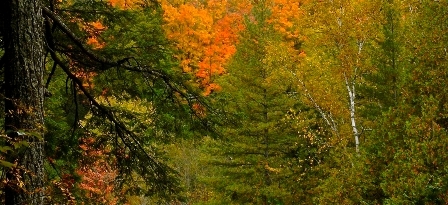Muskoka’s Biodiversity – Part 2: A changing environment

Last week’s article talked about biodiversity in Muskoka and why it is important for our environment and economy. Is Muskoka’s biodiversity getting better or worse?
A historical review of changes in Muskoka’s environment revealed the impact of humans, particularly in the changes that have occurred in the past two centuries – the devastation caused by waves of early logging in removing the pine, hemlock and mixed hardwood forests; extensive land clearing for agriculture; development of transportation systems and early settlements.
Changes in practice, and reductions in economic importance, of both the logging industry and agriculture, along with development of the tourism industry, have resulted in a dramatic turn-around in our environment and our biodiversity that has continued to the present day.
Decline in Biodiversity
The risks to biodiversity in Muskoka are best understood when placed in a context of global trends. The scientific community is agreed that, globally, the world is currently experiencing a significant decline in overall biodiversity.
While scientists do not agree on the exact percent of species loss, it is generally agreed that between 20% and 50% of all species on the planet risk extinction by 2100. In Muskoka-Parry Sound, there are currently 35 species identified provincially as Species at Risk.
This decline, referred to as the Holocene mass extinction event, is occurring for many reasons. Globally, human destruction and modification of natural habitat are reducing the capacity of the environment to support other species, leading to reductions in species’ population sizes and to local extinction. Direct exploitation of animals and plants also contribute.
Our development of industrial-scale agriculture and our rapid conversion of land into cities are also displacing many species, fragmenting populations and lowering genetic diversity. Human caused climate change and pollution are further exacerbating the difficulties faced by other species.
In Muskoka, similar processes, working on a smaller scale, are impacting our local biodiversity. All of these processes lead to lower overall biodiversity and lost resilience in ecosystems.
While there is an overall trend towards lower biodiversity, the pace of that decline varies from place to place and from system to system, and the true extent of the decline is still somewhat uncertain although it is clearly substantial.
In Muskoka, the generally high quality of our natural environment has buffered us from the high level of species extinction seen elsewhere in the world. However, even in Muskoka we cannot become complacent about biodiversity loss.
Many of the factors that contribute to biodiversity loss are at work here in Muskoka – climate change, development, pollution, invasive species – maintaining our high quality environment is central to continued prosperity in our recreation and tourism economy.
Direct economic use of biodiversity in Muskoka through forestry and agriculture has declined to only a fraction of its importance in the period from 1800-1950. In contrast, recreation and tourism industries continue to expand, with an increased rate of expansion predicted in the coming decades, along with population expansion. How will these changes impact Muskoka’s biodiversity and what will be the costs to our environment and economy?
We who live in Muskoka, and depend on our environment for both the quality of our lives and the strength of our economy, have much to gain by recognizing the risks we face, and treating them as a challenge to build the healthy environment we will need in our future.
Learn more about Muskoka’s changing biodiversity in the MWC publication Muskoka’s Biodiversity: Understanding our Past to Protect our Future, available at www.muskokawatershed.org. Next week in Muskoka’s Biodiversity – Part 3, we will talk about management approaches that can be taken by the Muskoka community to conserve biodiversity throughout our region.
Past articles are available in this blog under the Watershed Notes Articles category or under Past Articles in the Resources section.
